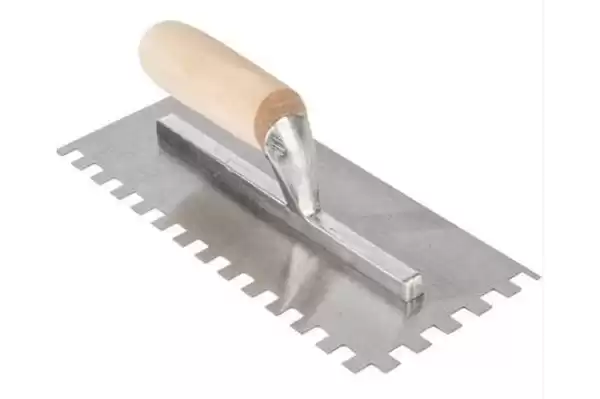When working with tiles, grout plays a vital role in both aesthetics and functionality. It fills the spaces between tiles, providing stability and preventing moisture from seeping underneath. To ensure a smooth, professional-looking finish, using the right tools is essential. Among these tools, the grout trowel stands out as a key player in the grouting process. But what kind of trowel should you use for grout, and how does it help achieve the best results? In this article, we’ll explore the different types of grout trowels, their functions, and which ones are best suited for specific tiling projects.
1. What is a Grout Trowel?
A grout trowel, also commonly known as a float, is a flat, rectangular tool used to apply and smooth grout over the surface of tiles. Unlike traditional trowels, which are used for spreading materials like mortar or cement, grout trowels are specifically designed for working with grout. They help evenly distribute the grout into the gaps between tiles, ensuring a uniform finish while preventing excess grout from building up on the surface of the tiles.
The main features of a grout trowel include:
- Rubber or Foam Base: This soft base allows the trowel to glide over tiles without scratching or damaging them.
- Flat, Rectangular Shape: The flat surface makes it easy to spread grout over large areas efficiently.
- Handle: Typically positioned at the center of the trowel for easy gripping, the handle allows for comfortable maneuvering and control.
2. Different Types of Grout Trowels
There are several types of grout trowels available, each designed for specific tasks within the grouting process. Choosing the right one can make a significant difference in the quality and appearance of your grout lines. Here are the main types of grout trowels:
1. Rubber Grout Float
The rubber grout float is the most common and widely used trowel for applying grout. As the name suggests, the base is made of rubber, which makes it flexible and gentle on tile surfaces. The rubber float is ideal for spreading grout over the tiles and pressing it into the joints.
- How to Use: To use a rubber grout float, apply a generous amount of grout onto the tile surface. Hold the float at a 45-degree angle and spread the grout across the surface, making sure to press it firmly into the joints. Use the edge of the float to scrape away any excess grout, leaving the joints full but the tile surfaces clean.
- Best For: Rubber grout floats are versatile and work well with both sanded and unsanded grouts. They are suitable for a variety of tiles, including ceramic, porcelain, and glass tiles, making them a go-to tool for most tiling projects.
2. Margin Trowel
The margin trowel is a small, rectangular tool with a narrower base compared to the rubber grout float. It is primarily used for precision tasks, such as working in tight spaces or applying grout to areas where a larger trowel would be cumbersome.
- How to Use: The margin trowel is typically used for smaller areas, such as corners or along edges where a standard rubber float may not fit. It allows for better control when applying grout in confined spaces.
- Best For: This tool is ideal for small repairs, grout touch-ups, or working in areas with intricate tile designs where more precision is needed.
3. Epoxy Grout Float
Epoxy grout is a type of grout known for its durability and stain resistance, but it is thicker and stickier than traditional grout. For this reason, a special epoxy grout float is needed. These floats have a stiffer rubber base, which helps push the more viscous epoxy grout into the tile joints.
- How to Use: Like a standard grout float, the epoxy grout float is used to spread the epoxy grout over the tiles. However, since epoxy grout is more challenging to work with, the float needs to be more rigid to effectively handle the thicker material.
- Best For: Epoxy grout floats are best used when working with epoxy grout in high-traffic or moisture-prone areas like kitchens, bathrooms, or commercial spaces. These floats are specially designed to handle the unique properties of epoxy grout, ensuring an even application.
4. Sponge Float
While not a traditional trowel, a sponge float is often used in the final stages of the grouting process. Once the grout has been applied and starts to dry, a sponge float can be used to smooth and clean the grout lines, ensuring a polished finish.
- How to Use: After the grout has been set for a few minutes, use a damp sponge float to wipe away excess grout from the tile surfaces, while simultaneously shaping the grout lines. The sponge’s absorbent surface helps remove grout without pulling it out of the joints.
- Best For: Sponge floats are crucial for cleaning grout and finishing the job. They are suitable for use with all types of grout and tiles and are often used in the final cleanup process to ensure the tiles are clean and the grout lines are neat.
3. Choosing the Right Grout Trowel for Your Project
Selecting the right grout trowel depends on several factors, including the type of tiles, grout, and the size of the area you’re working on. Here’s a quick guide to help you choose the best trowel for your project:
- For Standard Ceramic or Porcelain Tiles: A rubber grout float is typically the best choice for spreading and applying grout over large areas. Its flexibility and flat surface allow for efficient coverage and smooth application.
- For Small or Intricate Spaces: If you’re working in tight corners, around fixtures, or with decorative tiles, a margin trowel offers better precision and control.
- For Epoxy Grout: When using epoxy grout, it’s important to use a stiff epoxy grout float to handle the thicker material effectively.
- For Final Cleanup: After applying grout, a sponge float is essential for cleaning the surface of the tiles and shaping the grout lines, leaving a smooth, professional finish.
4. Conclusion
Using the right grout trowel is crucial for ensuring a smooth, even finish when grouting tiles. Whether you’re working on a large tile floor or a smaller, intricate backsplash, the choice of trowel will impact the quality of your results. From the versatile rubber grout float to the precision of the margin trowel and the specialized epoxy float, each tool plays a unique role in achieving the perfect grout lines. By understanding the different types of grout trowels and their uses, you can confidently tackle any tiling project with professional-grade results.
Post time: Sep-24-2024







